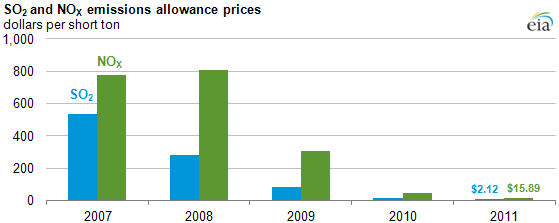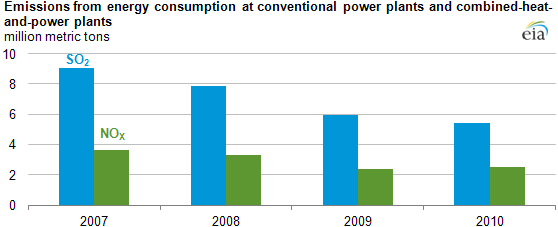
Emissions allowance prices for SO2 and NOX remained low in 2011

Download CSV Data
Emissions allowances are a component of policy tools used to reduce emissions of air pollutants such as SO2 or NOX. Such programs cap the total level of emissions, typically for a geographic area, without setting plant-by-plant limits. The price of emissions allowances is one important indicator of how the program is affecting the operating costs of polluting power plants, which in turn affects the order in which power plants are dispatched to meet demand, determining how often those plants run to generate power and produce the accompanying emissions.
The prices of annual sulfur dioxide (SO2) and summer seasonal nitrogen oxides (NOX) emissions allowances from the EPA's Clean Air Interstate Rule (CAIR) and the NOX Budget Trading Program (NBP) have fallen dramatically in recent years. Average SO2 prices in 2007 were $534/ton, and fell to an average of $2.12/ton in 2011. NOX prices showed a similar dramatic drop from $807/ton in 2008 to $15.89/ton by 2011. The drop in the value of allowances began after the D.C. Court of Appeals struck down CAIR, in July 2008, and continued through the end of 2011.
Several factors continued to contribute to lower prices for SO2 and NOX emissions allowances in 2011:
- Regulatory changes. CAIR was struck down by the D.C. Court of Appeals in July 2008. The same court temporarily reinstated the rule until EPA finalized a replacement. In its ruling, the court made clear that banked SO2 allowances could not be used in the replacement program, like they could be under CAIR. Furthermore, the court ruled that the NOX allowances awarded to states under CAIR were done illegally. After the court ruling, the value of SO2 and NOX emissions allowances plummeted.
- Environmental controls added. Contributing to the decline of emissions that freed up allowances for sale and reduced demand was the installation of new flue gas desulfurization (FGD) and selective catalytic reduction (SCR), pollution controls for SO2 and NOX reduction, respectively, by coal plants in anticipation of CAIR, state control requirements, and New Source Review settlements. After the court's CAIR rule decision, most of the projects were completed. From 2008 through 2011, FGD equipment and SCR equipment was added to about 69 gigawatts (GW) and 23 GW, respectively, of coal-fired generating capacity.
- Lower coal generation. There were two other factors that helped lower coal generation since 2009: reduced electricity demand overall and lower spot natural gas prices. Lower electricity demand from lagging economic activity since 2009 and warmer-than-normal weather in the fall of 2011 have contributed to lower coal generation. Moreover, historically low natural gas prices have increased the use of natural gas for power generation at the expense of coal. Coal generation in 2010 was 8% lower than in 2007 and 13% lower in 2009. Since significant amounts of SO2 and NOX emissions from the power sector come from coal plants, the reduction in coal generation contributed to the surplus of allowances.

SO2 emissions from the electric power sector fell from 9.0 million metric tons in 2007 to 5.4 million metric tons in 2010 (see chart above). NOX emissions fell from 3.7 million metric tons in 2007 to 2.5 million metric tons in 2010.